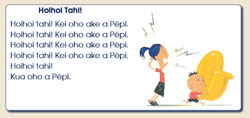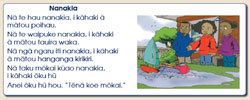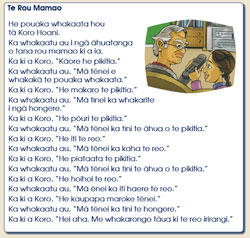|
|||||||||||||||
|
|||||||||||||||
%
responses 2008 ('04) |
|||||||||||||||
y4 |
y8 |
||||||||||||||
| Show the story titled HoiHoi Tahi! This story is about being noisy. As you read it aloud, think what the story is about. If you come to words you can’t read, just give them a go, and carry on with the story. When you’ve finished reading, I’ll ask you some questions. Student reads aloud independently of help from the teacher, but with encouragement. |
|||||||||||||||
 [Click on graphic to enlarge.] |
Percentage of words wrong: (not self-corrected) |
||||||||||||||
0 |
4 (2) |
11 (15) |
|||||||||||||
1-5 (1 word) |
3 (1) |
12 (11) |
|||||||||||||
6-10 (2-3 words) |
4 (4) |
15 (10) |
|||||||||||||
11-20 (4-6 words) |
9 (8) |
18 (15) |
|||||||||||||
21-30 (7-10 words) |
12 (10) |
14 (18) |
|||||||||||||
more than 30 (10 or more words) |
63 (68) |
29 (29) |
|||||||||||||
did not attempt or abandoned reading |
5 (7) |
1 (2) |
|||||||||||||
| 1. Have you read this story before? | student had read story before |
1 (1) |
1 (1) |
||||||||||||
| 2. What do you think “Hoihoi Tahi” means? | keep quiet, don’t be noisy |
69 (72) |
80 (83) |
||||||||||||
| 3. Who woke the baby up? | mum/girl/sister/woman |
20 (19) |
27 (29) |
||||||||||||
| 4. How do you know this? Show me where in the story it shows this. | baby wakes up when mum/girl/sister/
woman shouts at the boy to keep quiet |
20 (16) |
29 (25) |
||||||||||||
| Show the story titled Nanakia. Here is another story. It’s called Nanakia, and it’s about things that sometimes annoy us. Would you like to have a go at reading this story to me? If they say yes, carry on. If not, discontinue the task. Read the story out loud to me, then I’ll ask you some questions. Student reads aloud independently of help from the teacher, but with encouragement. |
|||||||||||||||
 [Click on graphic to enlarge.] |
Percentage of words wrong: (not self-corrected) |
||||||||||||||
0 |
0 (0) |
3 (2) |
|||||||||||||
1-5 (1-2 words) |
2 (2) |
7 (8) |
|||||||||||||
6-10 (3-4 words) |
1 (0) |
9 (9) |
|||||||||||||
11-20 (5-9 words) |
5 (3) |
14 (14) |
|||||||||||||
21-30 (10-13 words) |
7 (5) |
13 (13) |
|||||||||||||
more than 30 (13 or more words) |
58 (60) |
41 (38) |
|||||||||||||
did not attempt or abandoned reading |
27 (30) |
13 (16) |
|||||||||||||
| 5. Have you read this story before? | student had read story before |
0 (1) |
0 (1) |
||||||||||||
| 6. What made the balloons fly away? | the wind |
44 (43) |
56 (61) |
||||||||||||
| 7. What do you think the word“kähaki” might mean? | carried away |
0 (1) |
1 (2) |
||||||||||||
messed up/ruined |
1 (1) |
2 (2) |
|||||||||||||
| 8. Why do you think the girl is happy that her puppy has messed up her shoes? | because she has been able to
get a new pair |
13 (14) |
25 (26) |
||||||||||||
| Show the story titled Te Rou Mamao. Te Rou Mamao is a story about a grandfather and his granddaughter. Would you like to have a go at reading this story to me? If they say yes, carry on. If not, discontinue the task. Read the story out loud to me, then I’ll ask you some questions. Student reads aloud independently of help from the teacher, but with encouragement. |
|||||||||||||||
 [Click on graphic to enlarge.] |
Percentage of words wrong: (not self-corrected) |
||||||||||||||
0 |
0 (0) |
2 (2) |
|||||||||||||
1-5 (1-8 words) |
2 (2) |
10 (9) |
|||||||||||||
6-10 (9-16 words) |
2 (2) |
9 (11) |
|||||||||||||
11-20 (17-32 words) |
4 (4) |
19 (13) |
|||||||||||||
21-30 (33-48 words) |
5 (5) |
10 (14) |
|||||||||||||
more than 30 (48 or more words) |
39 (40) |
27 (20) |
|||||||||||||
did not attempt or abandoned reading |
48 (47) |
23 (31) |
|||||||||||||
| 9. Have you read this story before? | |||||||||||||||
student had read story before |
1 (1) |
1 (1) |
|||||||||||||
| 10. What do you think this story is about? | |||||||||||||||
a grandfather learning how to work
his new television/a girl helping her
grandfather to use his new television/
what a remote control is used for/
how hard it can be working out
how to operate things |
8 (14) |
29 (26) |
|||||||||||||
| 11. What name in Mäori is given to the remote for the television? | rou mamao: one or both words |
6 (7) |
9 (7) |
||||||||||||
| 12. Why does the grandfather end up listening to the radio? | he thinks the remote is too hard to use/
he thinks it is easier to just listen to the radio |
4 (8) |
19 (18) |
||||||||||||
Total
score: |
13–27 |
6 (5) |
32 (30) |
||||||||||||
10–12 |
5 (5) |
15 (18) |
|||||||||||||
7–9 |
17 (17) |
23 (19) |
|||||||||||||
4–6 |
42 (37) |
21 (18) |
|||||||||||||
0–3 |
30 (36) |
9 (15) |
|||||||||||||
| Subgroup Analysis [Click on charts to enlarge] : |
| Commentary: |
| Students were generally willing to try reading in Mäori, and three quarters of year 8 students and half of year 4 students attempted all three books. Even though most of the students did not attain instructional levels (90% or better) of oral reading accuracy, many of them were able to answer some comprehension questions from visual clues. There was no meaningful change in performance between 2004 and 2008. Mäori and Pasifika students predominated among the high achievers. |

